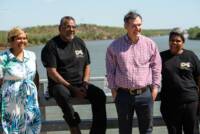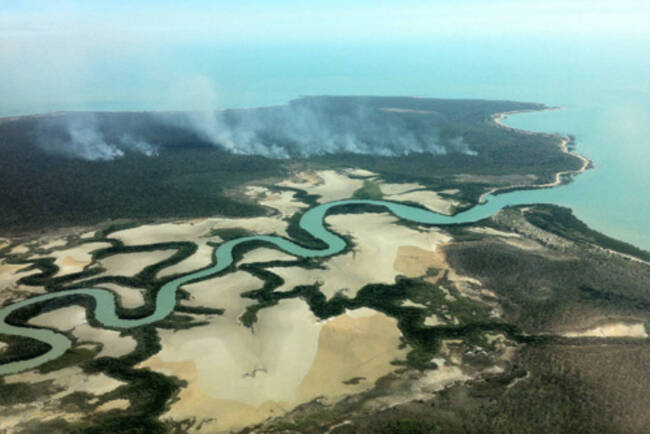Sea country rights
In 2008 the High Court of Australia confirmed that Traditional Owners of Aboriginal-owned Northern Territory coastline, have exclusive access rights to the tidal waters overlying their land.
North Australia coastline
The coastline of the Northern Territory mainland is 5,400km long and offshore islands contribute a further 5,500km of coastline. Around 55 per cent or 6,024km of this coastline is owned by Aboriginal Traditional Owner groups within the NLC region.
Northern Territory coastal and marine areas remain some of the world’s most intact environments, rich in natural resources, biodiversity and cultural heritage and support a range of growing regional and local economies and livelihoods. Sea country is very important to Aboriginal people. Sacred sites and songlines in the sea carry the same cultural importance as those on land.
The tidal waters and broader seas are important to the livelihoods of Aboriginal people living in remote coastal communities. In addition to the rights confirmed by the High Court in the Blue Mud Bay case, Traditional Owners of sea country also enjoy Native Title rights, exclusive access to closed seas, protection of sacred sites and management of Indigenous Protected Areas.
Exclusive Access to Intertidal waters
Aboriginal land is privately owned; it is not crown land, nor public land. Permission must be obtained in accordance with the Aboriginal Land Rights (Northern Territory) Act 1976 before entering these lands.
As a result of the Blue Mud Bay case, this also includes access to tidal waters over Aboriginal land. That means, permission from the landowner is required to access to the water and/or land between the high and low tide watermarks, regardless of whether you hold a fishing licence issued by the Northern Territory Government.
Interim arrangements were put in place in 2007, allowing all recreational and commercial fishers to access tidal waters over Aboriginal land. This arrangement ended on 31 December 2016. Since then, the NLC Full Council has waived the requirement for a permit to enter tidal waters overlying Aboriginal land in a series of waiver extensions, pursuant to section 5(8) of the Aboriginal Land Act.
On 29 July 2020, the NLC and the Northern Territory government (the NTG) signed the Blue Mud Bay Implementation Action Plan, which allowed to the end of December 2022 for the NTG to confirm and deliver in relation to its commitments, and for the NLC to undertake further consultations with Traditional Owner groups to find out which of them wanted to include their tidal waters in the open access plan.
Many traditional owner groups have agreed for their waters to continue to be accessed through to 31 December 2022. This interim arrangement will be subject to a new online registration process that will be in place from 1 March 2021.
Closed Seas
Two sea closures have been Gazetted under the Aboriginal Land Act (1978). They are in the Milingimbi, Crocodile Islands and Glyde River area (1981) and the Castlereagh Bay and Howard Island area (1988). Both closed seas are adjacent to Aboriginal Land and extend 2km seaward of the low tide watermark. Closed seas provide exclusive access to Traditional Owners. Permission from the land owners is required to access closed seas and can be granted through a permit.
Native Title determinations for sea country
Non-exclusive native title determinations cover sea country surrounding Croker Island in west Arnhem Land and in the north region of Blue Mud Bay in east Arnhem Land.
These determinations, in accordance with and subject to traditional laws and customs as recognised rights under common law, provide for Aboriginal people the ability to hunt and gather resources and practice traditions. Native title enables unobstructed access from other competing interests, including commercial operators and recreational interests.
Sacred Sites
All sacred sites are protected in accordance with the Northern Territory Aboriginal Sacred Sites Act (1989). Many sacred sites are registered in sea country. Access is not permitted within 100 metres of any sacred site, though some sacred sites may have more restrictive access. Visit www.aapant.org.au/sacred-sites for more information
Related Stories

Blue Mud Bay Plan will protect Aboriginal sea country rights
Sep 1, 2020
On 29 July 2020 the NLC and the NT Government signed the Blue Mud Bay Action Plan.


